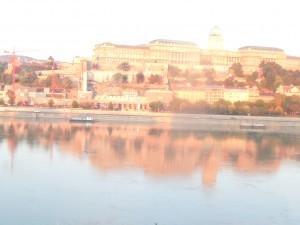Lisa Niver's Blog: We Said Go Travel, page 400
April 9, 2014
Ageless Granada, Spain
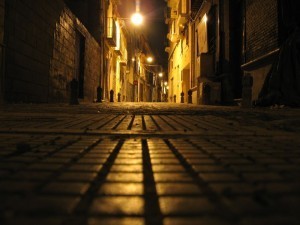 Travelers knew long before scientists that time is not a constant. There are places, everyone knows at least one, where time runs slow. Granada is such a place, and the rushed travelers who file into the city fight the pace of the city and invariably lose.
Travelers knew long before scientists that time is not a constant. There are places, everyone knows at least one, where time runs slow. Granada is such a place, and the rushed travelers who file into the city fight the pace of the city and invariably lose.
I was lucky to be a student in Valencia, and luckier still to have a girl willing to cross the Atlantic and go with me from city to city in Andalucia. She told me Andalucia, which is the driest part of Europe, means “place of water.” As you slide through the surprisingly green Sierra Nevada, you see what they mean.
The air here, a local explains, is always cool. The buildings seem universally white with black wrought iron fixtures. The exceptions are the palaces and Cathedrals atop the greater hills. Greatest of all is the “Red House”; the Alhambra. That’s our first stop.
We walked a bit around the grounds, which were endless. The fountains push water by no other means than gravity and feed the reflecting pools as they have for seven hundred years. A guide passes by with a group in tow. No fishing in these waters,he explained. The beauty of the water itself was what the Moorish kings prized.
The outer grounds were gardens full of fountains, and within the gardens the fortress itself had walls, palisades, moats, portcullises, and within the fortress stood a palace upon a palace. When the Spanish took the city and the Sultan who resided within cried when he turned it over. You need not ask why. Isabella and her heirs gilded the Lily by bulding more palaces, all in the latest fashions, on the grounds. Despite this, nothing seems newer. Through restoration or some other strange power, all seems equally ancient.
The city proper comes right up to the walls of the fortress, and we dined below, illuminated in sacred green, ordering whatever the waiter dared to mention. I asked Sara if she could imagine giving away the Alhambra, and she said it was living somewhere else after that boggled her mind. She ordered Granadas for dessert, which confused me until she explained that Granada is spanish for Pomegranate. They serve the seeds soaked in orange liqueur and covered in sugar. I finished mine and, feeling like a Sultan, ordered more.
Then it was truly night, though everything’s lit, so when we walk around the city we find no problem going up the cobblestones. Even though we are on the top of the mountain there is always something higher, so we follow the streets up past stalls selling guitarras, and you allow yourself to wonder how long something like them has guided this road.
A knowing crowd is happy to pull along passersby, and we found ourselves taken to a dancehall with wooden doors as black as the iron balconies above it. Inside, the smell of candles and sherry reassure you. The mountain air is not scented like Seville; you can’t smell Jasmine in every breath. Instead, you take in the sights and in them you discover the flavor of the place.
We took our seats at long tables. I had no idea what time it was. Before my phone ate my watch I compulsively checked the time. Checking a watch is admitting to waiting for something to begun or hoping something will end. I don’t recall checking mine that whole night.
Things got loud. A Man in a red sash claps and lifts the women in the air. The woman hold black fans and when the men lift them onto the tables, they wind those fans around themselves. Your eye is at their command and you look where the fans tell you. These Flamenco dancers, not Spanish at all my Basque grandmother maintained, are irrevocably associated with the country. Spain could no more banish the image then they could the Toro and his Toreador.
A song stops, and before the next one a dancer claims she will show us what her grandmother taught her. I knew that this is the way they danced a hundred years ago. It’s the way they will dance in a hundred more. We walked out later and saw what was clearly sunrise beyond the low hills. Unclear was the year. In Granada, there is no way of knowing when you are.
About the Author: Gregory Johnson is a writer living in Florida. He is the founder of Gainsayer.me and his fiction has been published by the Saturday Evening Post, Xenith, and Short, Fast, and Deadly Magazine. He holds a Masters in Creative Writing from The New School and is working on a novel.
Thank you for reading and commenting. Please enter our next Travel Writing competition and tell your story.
The post Ageless Granada, Spain appeared first on We Said Go Travel.
News: #RBQuests in Puerto Rico
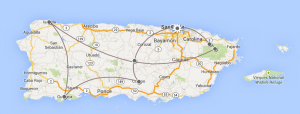 Latest News with We Said Go Travel:
Latest News with We Said Go Travel:
Thank you to Richard Bangs, Laura Hubber, Didrik Johnck, White Nile Media, Orbitz and the Puerto Rican Tourism Board for including me to filming in Puerto Rico. Read the articles and see photos on our Tagboard! or search the tag: #RBQuests. The suite of ten videos will be available soon!
I am continuing to publish three entries from our Inspiration Travel Writing Contest everyday. Our fourth Travel Writing Contest ended on February 14, 2014 with 505 people from 55 countries involved. There will be more entries published for all of April and part of May. Read all the stories published so far: Click here Winners will be announced in May. If you participated in the contest and did not receive an email from me, please email me. All of the articles are now ready for publication and everyone should have their links and dates! Thank you for your participation and patience!
Our FIRST travel video contest in conjunction with Richard Bangs will happen this summer with truly incredible prizes!! There will also be another writing contest on the theme of Independence this summer.
Thank you to Lena at Travel Wolf for picking We Said Go Travel for featured Travel Blog of the Month.
Article about Los Angeles and Adidas in the Jewish Journal. click here for Video of Noah Maze Yoga and Katie Eychis Hula Hooping class from Hoopnotica.
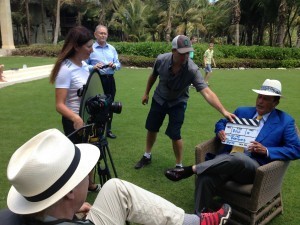 First posts from Puerto Rico: Old San Juan, Livin’ La Vida Loca, Meeting Sports Giants, and Adventures in Western Puerto Rico. Coming soon is the Go Pro underwater dive video as well as Go Pro video from the BEAST!
First posts from Puerto Rico: Old San Juan, Livin’ La Vida Loca, Meeting Sports Giants, and Adventures in Western Puerto Rico. Coming soon is the Go Pro underwater dive video as well as Go Pro video from the BEAST!
Thank you for your support. Connect on Facebook, Google+, Instagram, LinkedIn, Pinterest, SlideShare, Twitter, and YouTube.
Thanks again! Lisa (Click here to sign up for this newsletter. )
The post News: #RBQuests in Puerto Rico appeared first on We Said Go Travel.
April 8, 2014
Chasing the Lost Champion under the sun in Estonia
 Just as the wind began to pick up speed and the sun began to set, Jun and I made out way to the iconic Olympic hall. The journey there fuelled my imagination of the grandiose and spectacular image of arriving at this national pride. My body was motivated to keep moving as it surged with the feeling of awe one feels when standing on the exact same spot where a champion once stood. The historic moment of celebrating a victory or the crowning of a new glory, a feeling of chasing after a rush of invigoration only to capture for a fleeting moment what the Greek kings once felt, as they stood on the Acropolis, powerful and courageous. As my imagination played the slow motion of people rejoicing and the collision of golden cups, I thought to myself, perhaps this is what they meant by the importance of travelling.
Just as the wind began to pick up speed and the sun began to set, Jun and I made out way to the iconic Olympic hall. The journey there fuelled my imagination of the grandiose and spectacular image of arriving at this national pride. My body was motivated to keep moving as it surged with the feeling of awe one feels when standing on the exact same spot where a champion once stood. The historic moment of celebrating a victory or the crowning of a new glory, a feeling of chasing after a rush of invigoration only to capture for a fleeting moment what the Greek kings once felt, as they stood on the Acropolis, powerful and courageous. As my imagination played the slow motion of people rejoicing and the collision of golden cups, I thought to myself, perhaps this is what they meant by the importance of travelling.
As we approached Linnahall, the beauty of it seemed to slip further away. The sound of glasses clanking and the sound of laughter faded in my imagination. I stood at an abandoned place, used only for the gathering of underage teenagers sipping alcoholic beverages, or the lost at heart. Where was the moment of relishing in the glory of past champions? Where was the satisfaction of trekking past the city walls to find a national treasure? Was this all I was to capture; the reek of urine mixed with alcohol, the dampness of loneliness and the sedation of disappointment? I hid my disappointment and anger from Jun. Her goal was to reach a place where we could have a view of the sunset. She walked far ahead of me as I stood in the middle of the stadium, hoping to find an ounce of excitement buried in the walls. The further I walked through the grey eroding steps, the more I felt the corrosion of my hopes, rusting away with the abandonment of the stadium.
We reach the top of the stadium, where we capture a view of the sea front and the slow setting of the sun. As I listened to the breeze of the wind rushing against my ear, and watched the rhythmic waves lap against the shorefront, Jun offers me a Percy Pig gummy. As we look to the sea, we say nothing. Two friends sitting in silence, watching the sun set. Yet, every silence hides a riot.
Watching the waves lap against the shorefront, I thought about what it must be like under the sea; the school of fishes swimming by, the sound of seagulls muffled about the surface of the water. I wondered if I would be cannonballed out of the water if I swam to close to the back of the boat. I imagined how cold the water might be, and if the fishes would feed on my Percy Pig gummy. Finally I started to wonder how quickly my thoughts past, like how quickly I had forgotten about my chase and disappointment. I continued looking out to sea, staring into the abyss and it stared back into me. I felt everything I had been running from. This fleeting moment of time, the quick transitions between my emotional states, the anticipation and descend into disappointment, were all distractions that hid the raw mix of fear and excitement that comes with youth. The whole month, as I jumped from city to city, landmark-to-landmark, it was like an addiction to chase the past in search of finding a sense of empowerment in order to run away from my fears. Every sense of victory I had tried to align myself with was the self-deception away from the cries of weakness.
What I found as I laid on the cold concrete, feeling the coldness of abandonment and stagnation of activity was the freedom of being. Here laid a once iconic congregation, and now it stood, surviving the harsh winds and farewells of its visitors as it watched the routine of the sun rising and setting. I never found the fleeting celebratory spirit, but I uncovered its solitary strength. A place stripped bare of its glorious embellishments, revealing its scars and erosions, yet bearing the rays of the sun every single day. Still, it finds the strength to remain and stand strong long after the days of celebrations.
A celebration of a victory only lasts as long as you realise the next war, and there is always one more to fight. Perhaps the reason to travel is to unravel the mysteries of the unknown as you uncover the strengths of your self.
About the Author: Cherilyn Woo is a 23 year old an aspiring theatre director who loves the wonders of imagination. While she constantly hopes for world peace, she is always on the lookout for an opportunity to embrace the chaos of travelling. Having travelled to Europe, America and the Middle East, she spends most of her time in Singapore where she was born and raised.
Thank you for reading and commenting. Please enter our next Travel Writing competition and tell your story.
The post Chasing the Lost Champion under the sun in Estonia appeared first on We Said Go Travel.
The Nude Bathouses in Germany
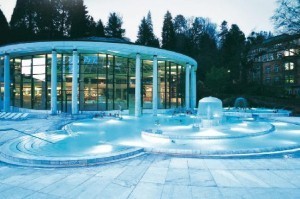 There are times, when my mind is free from occupation and my heart yearns to reminisce, that my memory will alight to that horror. Bodies pale and shriveled staring back at me, staring through me. Signs, scribbled in German, barking their orders at me. My face reddens, my stomach churns, and my brain is unable to understand just what it is that I am witnessing. My girlfriend is frozen next to me, lost in an even deeper stupor than mine. She is wearing a floral pleated bikini, and I am in a speedo.
There are times, when my mind is free from occupation and my heart yearns to reminisce, that my memory will alight to that horror. Bodies pale and shriveled staring back at me, staring through me. Signs, scribbled in German, barking their orders at me. My face reddens, my stomach churns, and my brain is unable to understand just what it is that I am witnessing. My girlfriend is frozen next to me, lost in an even deeper stupor than mine. She is wearing a floral pleated bikini, and I am in a speedo.
We are in Baden Baden, Germany, a town I had never heard of until the night before, an approximate five minutes before we bought the tickets from Strasbourg, France. It is my first time in Europe, and though I had assumed I would be hitting every major city on the map, I’ve quickly realized that everything is not as a close together as they seem, and train tickets cost money. So rather than Munich or Berlin, we opt for the posh village of Baden Baden, located just over the border in the Black Forest. We did not know much about it, but after being separated by an ocean for nearly three months, we would have been happy to spend a day on Tatooine.
Now of course, being Americans, we had no idea what to expect at a bathhouse. The pictures on the brochure we found looked pleasant enough, and with the weather forcing us inside, it seemed like a reasonable idea. Besides this is what traveling was supposed to be, dipping your feet into new experiences, even if those new experiences were a bathhouse in Germany. Upon entering we realized we were gravely unprepared. Almost every other patron was either already clad in bathing suits, or held a bag the presumably carried their suits. We were wearing sweaters and jeans. Luckily, there was a gift shop selling suits, complete with a changing room next to the cashier, shielded by a shower curtain. Unluckily, the selection of suits was very European, and the longest suit I could find barely reached where my hip meets my thighs.
Determined to enjoy ourselves despite our outfits, we approached the bathing area with an open mind. It was truly a beautiful building, with pools that stretched within the building and outside, with separate hot tubs and waterfalls. Most of the clientele was downright geriatric, and despite being decidedly un-American in apparel, many were rather obese. Nevertheless, we were able to relax immensely. After pruning for a couple hours, we exited to find towels.
We had been operating under the assumption that the bathhouse supplied the towels, much like a hotel pool. But alas, after communicating with an employee largely in hand gestures, we realized that towels were not supplied but rather rented, and that there were two locations at which we could make the transaction. The first was the front desk, in the lobby, and seeing as neither one of us felt comfortable venturing out there in our suits to retrieve them, we opted for the second option, being the spa room at the top of a spiral staircase.
After ascending the stairs, we spotted a wall lined with cubbies brimming with towels across the lobby. We took aim, but before we could reach it, we were stopped by a stern attendant. “This,” she explained, “is a nude area only.” The words took a minute to register, and when we finally came to, old, fat, naked Europeans, almost entirely men, surrounded us. They were staring in our direction, but I knew it wasn’t at me. Seeing as we were the youngest ones there by a decade or two, and that she is a gorgeous girl to begin with, the patron’s anticipation was palpable. She reached for my hand, pulling me back down the stairs. She struggled to find the words, but I knew what she was trying to say. No towel was worth that.
We laughed it off later that night when we washed down our German dishes with pints of beer. But later on the train, when we were battling sleep, we began to discuss it again. Almost immediately, we wished we had done it. After all, the worst they could do is look. And neither of us are ashamed or embarrassed by our bodies. Sure we had abandoned to confines of comfort simply by going to the bathhouse and wearing those suits, but in travel, as in life, there should be no half measures. I had an incredible time in Europe; it sparked in me desire to see the world. But it also inspired a creed with which I will forever live by. If given the chance, get naked.
About the Author: Harrison Arnold is a Student, Writer, Newborn Traveller
Thank you for reading and commenting. Please enter our next Travel Writing competition and tell your story.
The post The Nude Bathouses in Germany appeared first on We Said Go Travel.
Harry Potter’s World – Would You Want to Visit It?

In the summer of 1997, J.K.Rowling released the first novel in the series, Harry Potter and the Philosopher’s Stone , which gained popularity pretty fast. It wasn’t until much later – in early 2000s- that I actually got to read the book , as well as most from the series. The dark tone – specifically Rowling’s obsession with death -, which was criticized by many, hadn’t appealed too much to me either, so I abandoned the books.
However, having seen most of the movies and played some of the games, the world in which Harry Potter’s character lives his life – and does his magic – has definitely appealed to me.
If you have seen the movies, you probably noticed that some places featured in them are pretty real; and they are in London. Yes, that same London which I’ve been in love with for years and I have visited back in 2011.
The most important places in London where the movies were filmed are:
King’s Cross Station – remember Platform 9 1/2 and the trolley which vanished into the magical realm via a wall ?
St. Pancras International – right next door to King’s Cross, this is where Weasley’s magical Ford Anglia takes off (Harry Potter and the Chamber of Secrets)
Piccadilly Circus – Harry, Hermione and Ron rush through London’s West End (Harry Potter and the Deathly Hallows)
Millennium Bridge - the bridge collapses at the beginning of Harry Potter and the Half-Blood Prince
Leadenhall Market – was used as Diagonal Alley in Harry Potter and the Philosopher’s Stone.
Westminster Tube Station – very much used in Harry’s travelings in Harry Potter and the Order of the Phoenix.
Lambeth Bridge – the Knight Bus squeezes between two oncoming double-decker buses in Harry Potter and the Prisoner of Azkaban.
Charing Cross Road – in London’s West End, you’ll find both Diagonal Alley and The Leaky Cauldron pub. Stop for a pint , maybe you get to meet some wizards.
But if Orlando is easier for you to reach, then the Wizarding world of Harry Potter is the place to check out if you are a fan of the series (books and movies). The theme park features: Diagonal Alley, Knockturn Alley, King’s Cross and Harry Potter and the Escape from Gringotts.
Photo Credit: amandabhslater via Compfight
The post Harry Potter’s World – Would You Want to Visit It? appeared first on We Said Go Travel.
The Sisters at Petra, Jordan
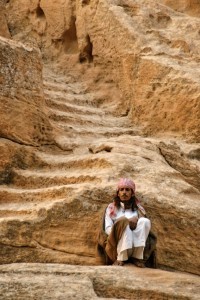 When I first meet the American sisters, I wonder why they would ever move here. Everyone in this tiny Jordanian village belongs to the same Bedouin tribe. Everyone except them.
When I first meet the American sisters, I wonder why they would ever move here. Everyone in this tiny Jordanian village belongs to the same Bedouin tribe. Everyone except them.
My friend and I sit cross-legged in a shadowy room, our knees flirting with the edge of the crackling fire. Eight others perch around us – all men, save for the two Americans. The sisters don’t wear hijabs; instead, they sport full afros.
Khaled, our new friend and host, sits across from us in his white robes and red-checked keffiyeh. He sucks on a hookah pipe. Smoke seeps from his lips to mingle with that of the fire, while the sisters babble away in Arabic with surprising ease.
A boy approaches with a basin and a jug. One of the sisters nods at me, and I rinse my hands as he pours the water. Dinner is served.
We’re ushered to a space away from the flames, and someone places our cushions on the concrete floor. The sisters collapse onto them with practiced grace, but I struggle to recover the flexibility of my childhood. I shift my legs as pins and needles begin to tingle my feet.
Khaled brings in an enormous round tray, more than 50 cm wide. One of the sisters speaks to us for the first time.
“Mansaf.” She points to the massive heap of rice and poultry, yellowed with odoriferous spices. “This is with chicken, but if you ever come back for a real party, it’ll be lamb.”
She scoops up some rice from the tray. Between handfuls, she gestures toward the man beside her. His face contains as many lines as a spider’s web, and his eyelids droop with age.
“If you’re lucky, Mohammed will make it. There’s nothing as tasty as his lamb mansaf.”
As she repeats herself in Arabic, Mohammed smiles and pushes the tray toward me and my friend. Following custom, we use only our right hands, but as a leftie I struggle to tear off small chunks of chicken, and resign myself to eating mainly rice. Each time I think I’ve had enough, Mohammed grins and urges me to eat more.
When I feel full to the point of bursting, Khaled invites us back to the fire, and pours us tea in shot-sized glasses. Candy-apple sweet. I grasp the rim and turn to a little boy who has come over to greet us. At Khaled’s urging, the boy bends to give me a hesitant kiss on the cheek, an action that’s met by a chorus of chuckles.
As I accept a second cup of tea, I lean in to the sisters and ask the burning question: why here?
Surely it’s a question they’ve heard before. They arrived as travelers three years ago, and never left. Although they work at the nearby tourist site of Petra, they’ve learned Arabic and found a welcome place in this community.
“The answer is easy,” one says. “A simple life shared with beautiful people.”
She pauses to call out to Mohammed, who straddles the threshold of the door. Her teasing tone makes his eyes twinkle.
“I’m telling him he needs to eat more before he leaves,” she explains. “He always says that to us, after all.”
The other sister returns to my question.
“Look,” she says, “we’ve traveled the world over, and the people in Jordan are like nowhere else. So friendly, so hospitable.”
“It’s just one big family, and now they treat us as part of it.”
I nod, and resist further nosiness. I don’t ask if they hope to stay forever, if they plan to marry Bedouin men. I don’t even ask think to ask their names.
Instead, I shift my legs until I finally find a comfortable position. I sit back and gaze into the fire, at the warm light cast on Khaled and his family’s faces. I watch the way these people look at each other, eyes always connecting.
The sisters’ laughter twirls between the low murmurs of the men. The conversation never lulls, and the cellphones I’ve see the Bedouins carry stay hidden in the pockets of their robes. There’s a warmth in this room, a feeling created not just by the fire, but by the genuine interest in human interaction, in spending time with your loved ones.
I realize it’s getting late. My friend and I have somewhere to be, tickets for the touristy “Petra by Night.” But the moment I empty my glass, Khaled raises the kettle in an offering.
I nod. As the sugary amber liquid fills my glass, my friend and I exchange a glance. We see no reason not to linger awhile longer.
About the Author: Ellen Keith is a Canadian freelancer who is currently based in Amsterdam. Between her travels, she’s working on her MFA in creative writing through the University of British Columbia.
Thank you for reading and commenting. Please enter our next Travel Writing competition and tell your story.
The post The Sisters at Petra, Jordan appeared first on We Said Go Travel.
April 7, 2014
Tea for two In Jordan
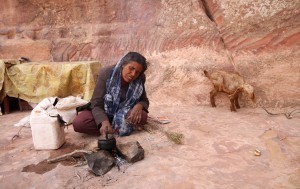 Jordan, as framed in the neat oval of a Boeing 737 window, resembles Tatooine from the sky: a sea of rusty red sand, canyons and jagged mountains. As viewed through the windshield of a Citroën C3 sedan cruising Highway 15, the landscape is monochromatic, the sky a hazy gray. There are signs of civilization in the scattering of low, cement-block houses, but the single constant show of human habitation are the steely-faced traffic officers conducting impromptu roadside checks.
Jordan, as framed in the neat oval of a Boeing 737 window, resembles Tatooine from the sky: a sea of rusty red sand, canyons and jagged mountains. As viewed through the windshield of a Citroën C3 sedan cruising Highway 15, the landscape is monochromatic, the sky a hazy gray. There are signs of civilization in the scattering of low, cement-block houses, but the single constant show of human habitation are the steely-faced traffic officers conducting impromptu roadside checks.
“Do you know of any place in the U.S. like this?” I asked my husband as we drove along.
“No, but if I was shooting a sci-fi, Star Wars-like movie, I’d definitely consider this,” Matt said.
But it was actually the Tunisian desert that stood in for Luke Skywalker’s home planet in the sci-fi franchise. Petra didn’t cement its spot in cinematic pop culture until 1989, when its Al Khazneh tomb (popularly known as “The Treasury”) served as the resting place of the Holy Grail in “Indiana Jones and the Last Crusade.”
The Treasury’s fame, however, somewhat betrays the grandness of Petra as a whole. In reality, the Treasury is simply an elaborate façade, a single monument among hundreds in a 264,000- square-meter complex. The Nabataeans, members of an ancient Arab tribe, created this city in stone more than 2,000 years ago. Most of the structures that still remain, including the Treasury, are tombs carved into the red sandstone hills.
It was while searching for the path to the Treasury overlook that Matt and I spied a small herd of goats nibbling on the sparse desert vegetation. I followed and photographed the animals as they ate.
Suddenly, the goat’s bleats were answered by a guttural, human response. I turned to see a middle-aged Bedouin woman crouched above me on the platform entrance of the tomb for Sextius Florentinus.
The woman quickly switched from goat to broken English when she noticed Matt and I.
“Tea? Postcards?” she asked, hopeful.
Curious about the woman’s culture, Matt and I mounted the steps of the tomb platform. We expected to see some sort of concession stand but were instead confronted by a trio of blackened, ashy rocks arranged atop the sandstone. Our host motioned for us to sit beside the rocks, and we watched as she began collecting and breaking sticks to rekindle her fire. Periodically, she’d venture to the far corner of the platform, cup her hands around her mouth and shout a single Arabic word. It sounded like a name.
“ABIR!” she called, her voice echoing through the canyon.
Satisfied with the stick arrangement, the woman produced a BIC lighter from a pocket and set the wood aflame. She then poured water from a white plastic jug into a tiny weathered teapot she rested atop the fire.
As we waited, a small figure, a little girl about 3 years old, rounded the outside of the tomb and made her way toward us. The child’s unwashed hair stood on end. She wore unzipped jeans, a dirty pink sweater with a large hole in the front and a pair of too-large, unzipped canvas boots.
Smiling sheepishly, the girl set to peddling her family’s wares: postcard sets of Petra. When we politely declined, she stomped off and, with practiced skill, threw her arms around the spindly legs of a black and white kid. She carried the goat back to the fire and repeatedly body slammed him toward her lap to make his legs fold into a reclining position.
And still the water had not boiled.
“Tea,” Matt hissed at me. “It had to be tea!”
Like her mother, the little girl would periodically venture to the far corner of the platform and shout a name across the canyon. She did this about three times before a teenage girl, presumably her sister, emerged. As a berry picker lugs her haul from bush to bush, this girl dragged a large bucket. Her haul, however, was not berries but rocks. Sandstone rocks she desired to sell to us.
I showed the teen the rocks already in my shoulder bag, the ones I had just collected from the same canyon floor. No, we didn’t need to purchase any rocks.
Was the tea ready yet?
It was. Syrupy sweet, the concoction tasted like sugar water.
Careful not to offend our host, Matt and I drank it all and then paid the woman five times the set price for her trouble. Delighted, the teen presented us with a rock — on the house.
Many months later, while cleaning out my shoulder bag, I uncovered a handful of colorful sand – all that remained of the soft rocks — embedded in the inside folds. The discovery made me smile.
About the author: Megan V. Winslow is a writer and photographer who recently returned to the U.S. after a 6-month adventure around the world with her husband, Matt. Originally from Florida, Winslow relocated to San Francisco in January. She enjoys hiking, gardening and swing dancing.
Thank you for reading and commenting. Please enter our next Travel Writing competition and tell your story.
The post Tea for two In Jordan appeared first on We Said Go Travel.
My Grand Canyon in the USA
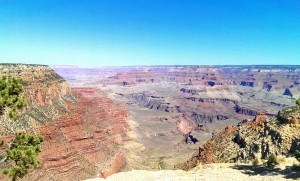 Of all the gifts that Nature bestows on mankind, few are as powerful as perspective, and if there is one thing I gained standing on the south rim of the Grand Canyon last June, it was that irrefutable feeling of being dwarfed by the scale of the chasm that lay before me. The view extended on as far as the eye could see, with the resplendent walls fading into indigo and violet as the Canyon receded into infinity to meet the bright blue sky. However, the most humbling observation was not the immense size of the gorge alone, it was the fact that the Canyon had been carved, inch by inch, by the great river that flowed unseen over a mile below the rim. What once must have begun as a ditch is now a palace of rock, stone, and light- 300 miles long, over a mile deep, and in places, nearly 20 miles across! Surely there is no greater monument to the power of time than the Grand Canyon.
Of all the gifts that Nature bestows on mankind, few are as powerful as perspective, and if there is one thing I gained standing on the south rim of the Grand Canyon last June, it was that irrefutable feeling of being dwarfed by the scale of the chasm that lay before me. The view extended on as far as the eye could see, with the resplendent walls fading into indigo and violet as the Canyon receded into infinity to meet the bright blue sky. However, the most humbling observation was not the immense size of the gorge alone, it was the fact that the Canyon had been carved, inch by inch, by the great river that flowed unseen over a mile below the rim. What once must have begun as a ditch is now a palace of rock, stone, and light- 300 miles long, over a mile deep, and in places, nearly 20 miles across! Surely there is no greater monument to the power of time than the Grand Canyon.
“Each man sees himself in the Grand Canyon – each one makes his own Canyon before he comes; each brings and carries away his own Canyon.” This quote by Carl Sandburg is featured prominently in the Grand Canyon National Park visitor center, and it remained in my thoughts as I hiked down the trail into the Canyon that warm summer morning. Surrounded by the panoramic majesty of the great crevasse, I reflected on Sandburg’s words. We have all carved our own canyon walls, and not so differently from the Colorado River. My solo trip to Arizona that summer was my gift to myself after a pretty tumultuous year- one that had seen the end of a long-term relationship, a move to a new town, and the start of a new job. All of those events were landmarks in my own history, a fact which was poignantly brought to mind by the fact that I was walking in a place where two billion years of geologic history are laid bare.
Indeed, the Canyon keeps no secrets! Layers of the rock tell of a past of volcanic eruptions and prehistoric creatures that inhabited long-forgotten seas. There are places carved in the rock where the water must have run smoothly eons ago, lapping gently at the stone. Other places, the jagged edges speak to the fury of the rapids and crashing waves, tearing the rock away in violent chunks. How similar we are with the Canyons we create! Whether the moments of our lives were made in times of peace or in times of trial, what’s done is done; there is no changing what has been etched in stone. The life we have created – our Canyon – is permanent and unchanging; an everlasting monument to the choices we have made and the way we have spent our time. In light of this, how important it is to make the time we have count! The Colorado River has had two hundred fifty thousand lifetimes to do its work; we each have but one.
There is a webcam set up at Yavapai Point, on the south rim of the Canyon. Very soon after I returned from my trip last June, I discovered the webcam feed online and bookmarked it. Since then, I have viewed the webcam quite often, sometimes several times a week. I simply direct my browser to the site and wait for the picture to load, admiring the familiar stone walls of the Canyon. Sometimes the chasm is splashed with the bright hope of the early morning rays, other times it is covered in billows of fog, still other times it is bathed in the golden light of the setting Southwestern sun. The solidarity of the walls is comforting: I may be busy, stressed, or tired now that I am back to the demands of my twenty-first century life, but the Canyon is always there, unchanged, just a click away.
Of course, I know that is not entirely true: somewhere far below, deep down in the crevasse, the mighty Colorado is still working, continuing to push ahead into the future, in spite of the beauty (and even pain) that its past has created. I only hope that I can live the same way.
About the Author: Paul Rotramel is a public school music teacher. He spends his time away from the classroom visiting America’s national parks and baseball stadiums.
Thank you for reading and commenting. Please enter our next Travel Writing competition and tell your story.
The post My Grand Canyon in the USA appeared first on We Said Go Travel.
Historic City of Ayuttaya: Carefully Picking Things Up
The challenge posed by this site is to make sense of the scattered remains of a former strong Southeast Asian empire’s capital. The historic city of Ayutthaya gained global importance due to its strategic trading location and strong diplomatic networks that were highly prized by the Chinese, Indians, Japanese, Dutch, Portuguese, and even the British. Its inscription to the World Heritage List, however, is anchored on criteria (iii): to bear a unique or at least exceptional testimony to a cultural tradition or to a civilization which is living or which has disappeared.

The ruins of Wat Phra Mahathat, the most sacred temple in Ayutthaya as it once held sacred Buddha relics.
I agree with Els Slots (www.worldheritagesite.org) that ruins here are really ruins. It is a bit sad that nearly everything here was destroyed during the 1767 Burmese siege. To think that Ayutthaya even brought the downfall of the powerful kingdom of Angkor in the 14th century, the present condition of this site does not, in any way, give justice to how it used to be based on historical records and accounts, descriptions and praises, and even map renditions. It is interesting to note, furthermore, that with the fall of Ayutthaya, the role of Malacca in Malaysia as the sole trade hegemone in Southeast Asia was eventually cemented and secured – traveling makes more sense if you can stitch stages in history all together, right? Nevertheless, I believe that this old city’s current state still holds a distinct charm and mystery for heritage enthusiasts and tourists alike.

Wat Chaiwatanaram is probably the most beautiful temple, but it is not a listed as a World Heritage monument as this is located outside the island that makes up the core zone. Notice the Khmer influence on this temple.
Upon arriving Ayutthaya, my agenda there was not really clear: either I visit the World Heritage-inscribed sites only, or just choose some major ones and pay those other temples that didn’t make it to the inscription a visit as well. Eventually, I decided to do the latter. Much to my surprise, two temples that are not inscribed left me with really strong impressions: Wat Yai Chaimongkhol and Wat Chaiwatanaram. Interestingly, these two temples are even the most photographed ones used in advertising Ayutthaya!

Wat Yai Chaimongkol: rows of the sitting Outon style Buddha in the courtyard
I later found out that the WHS core zone is only limitted to the those temple-ruins in the island proper. I actually used this very useful website as my guide in understanding better the composition of the historic park: http://www.ayutthaya-history.com/Temples_Ruins_List_C1.html
Among the inscribed temples, however, Wat Rachaburana probably offers the most unique experience with its two-tiered crypts and few remaining old murals inside the principal prang. I also observed that not too many tourists climb the prang to see these! Maybe, they do not know about it.

Wat Rachaburana: ancient murals inside the crypts. Climbing the tower can be an arduous thing to do, but it definitely is worth it! Besides, not many tourists know what is hiding inside :)
Although the scales of Wat Phra Mahathat and Wat Phra Si Sanpet are impressively grand, these being largely in ruins, it was hard for me to reconcile the fact the these two sites were the most important — socially, politically, and religion-wise — during the peak of the Ayutthaya empire. There is obviously a big disparity between “status quo” and “history” in these two major sites. Nevertheless, seeing the Buddha head entangled among the roots of a tree in Wat Phra Mahathat was still among the highlights of the visit.

Wat Phra Mahathat’s iconic Buddha head eaten up by a Bodhi tree.
One can also not fail to notice the seemingly uniform and cohesive images of the Buddha all around Ayutthaya, though most have been mutilated. The style of the images is one of the signature exponent of the Outon style, which is a cross between the earlier Sukhothai architecture and to that of nearby Lopburi. Outon style is, thus, commonly referred to as the Ayutthaya style as well.

The picturesque Ayyuthayan chedis of Wat Phra Si Sanphet
I also managed to visit other temples such as Wat Phra Ram (its picturesque late afternoon reflection on the pond was very calming), Viharn Phra Mongkol Bopit (the only temple to be completely reconstructed), and Wat Chang complex where the elephant rides are being executed. If there is one thing I like most about Ayutthaya, it is how the temples and other monuments are really taken care of despite their conditions.

I certainly enjoyed riding an elephant while exploring the ruins of Wat Chang.
Let’s face it: it’s really ‘just’ the best — and the only! — thing that they can do with whatever remains standing (or leaning, falling, collapsing).
The post Historic City of Ayuttaya: Carefully Picking Things Up appeared first on We Said Go Travel.
Love at first sight in Hungary
I had the opportunity to travel across different parts of Europe last year and savoured the experience. And like travellers before me, I also found something to love about every city that I visited. But when it came to Budapest, it was love at first sight and it was the river Danube that created that magic feeling.
My love affair with the Danube started much before I even set my eyes on the river. The reason was the piece of music, “The Blue Danube”, that I learnt as part of my piano lessons, as a school-girl. My sense of geography was poor those days and thanks to the composition, the Danube existed in my imagination as some magical river.
Not in my wildest dreams, did I ever imagine that I would actually set foot in the city through which the Danube flowed and enjoy a long ferry ride across it. It was a speed boat that our hosts had arranged and it was a joyful feeling to sail across the Danube while trying to hum the tune. Once the boat picked up speed, one had to hold on for dear life, but that only added to the sense of exhilaration and enchantment, as the waters mirrored the magic of Buda and Pest and the Chain Bridge that connected the two cities.
I am sure that it must have been my Fairy Godmother from the land of magic who also ensured that I got a room on the 7th floor of a hotel, facing this beautiful river. On all the nights that I spent in Budapest, I would pull the curtains wide apart, so that I could go to bed, seeing the Danube and look at it the first thing in the morning, as I woke up. With the palace, the churches and other buildings reflecting their twinkling lights on the Danube, those nights in Budapest seemed like fairy-land and I wished that I could live in this city forever or at least return to it again and again.
While the Castle Hill and the Royal Palace, looked imposing when their lights were picked up by the Danube as also the Chain Bridge, it is the House of Parliament building, which held my attention. Bearing a strong resemblance to its British counterpart, the building is grandeur personified in its construction. I walked around it in awe, with my ears wide open to absorb the guide’s narration. How fortunate were the politicians who had the privilege of conducting their business in these surroundings, I thought.
Could one ask for more memories to treasure about Budapest and the Danube? Sometimes one doesn’t need to. Entering a little café, adjoining the church, there was an orchestra, making beautiful music with a piano-accordion, in lieu of a piano. I just pulled a chair and sat down rapt. It was only a matter of time before the mellifluous notes of “The Blue Danube,” wafted into the air. I could not sit still anymore. There were no men willing, so I just pulled a sporting lady friend from our group and we waltzed in and out between the chairs, to the magical tune of my growing-up years. The orchestra and audience may have looked on in amazement at the two crazy Indian ladies but I was oblivious … for my eyes were gazing out into the distance, through one of the windows, as the Blue Danube, flowed silently, touching my soul. I lived my dream in Budapest and I hope that I can go back to relive it.
About the Author: Melanie is a Bangalore-based Independent Writer, who loves to travel and write about her experiences. For Melanie, life is one big adventure but there is nothing quite like travel to widen one’s horizons, says she!
Share your Place of Inspiration in our Travel Writing Contest. First Prize $1000usd cash, free entry!
The post Love at first sight in Hungary appeared first on We Said Go Travel.
We Said Go Travel
We Said Go Travel is a global community of over sixteen hundred writers with articles from every continent.
Stories are shared with photos and video from a perspective of the transformative power of travel. We Said Go Travel has hosted live and online events as well as travel writing contests around the world. ...more
- Lisa Niver's profile
- 57 followers


